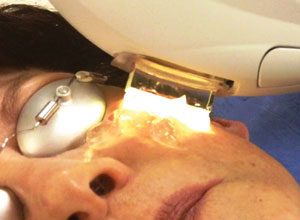 |
| IPL helped improve visual outcomes in DED patients. Photo: Derek Cunningham, OD |
Intense pulsed light (IPL) treatment is used in dermatology to treat dermal disorders but has also been shown to improve meibomian gland function, stabilize the tear film and reduce ocular surface inflammation in DED. Researchers recently assessed tear film lipid layer (TFLL) alteration and function in patients with evaporative DED using tear interferometry post-IPL.
The study included 86 participants (142 eyes) with DED who were separated between an IPL treatment group and a sham treatment group. Ocular Surface Disease Index (OSDI), noninvasive tear breakup time (NITBUT), interferometric fringe pattern, fluorescein staining and the meibomian glands were assessed.
At three months, TFLL, NITBUT, meibomian gland dropout, meibomian gland quality, meibomian gland expressibility, fluorescein staining and OSDI improved significantly in the IPL group, while the sham group had no significant improvements. Additionally, the frequency of artificial usage was significantly less in the treatment group, with decreased OSDI scores due to enhanced TFLL and tear film stability.
The study showed NITBUT significantly increased, showing an improvement in tear film stability. “Because of increased meibum secretion and change in the viscosity and quality of meibum, the tear film becomes more stable, resulting in an improvement in dry eye symptoms,” the authors explained in their study.
A previous study showed lipid-based treatment is effective in improving the signs and symptoms of dry eye, and in this current study, TFLL showed a significant correlation with reduction in artificial tears. Another previous study noted, “Significant improvements were observed in tear protein concentrations and molecular weight after IPL treatment that proved it improved tear protein and lipid content and composition.”
“Therefore, as the results show, the TFLL score significantly decreased (improved TFLL) and was significantly correlated with improvements in NITBUT, artificial tears and OSDI score, elucidating that improved TFLL contributed to reduced signs and symptoms of DED,” the authors concluded.
Song Y, Yu S, He X, et al. Tear film interferometry assessment after intense pulsed light in dry eye disease: a randomized, single masked, sham-controlled study. Contact Lens Anterior Eye. August 22, 2021. [Epub ahead of print]. |

